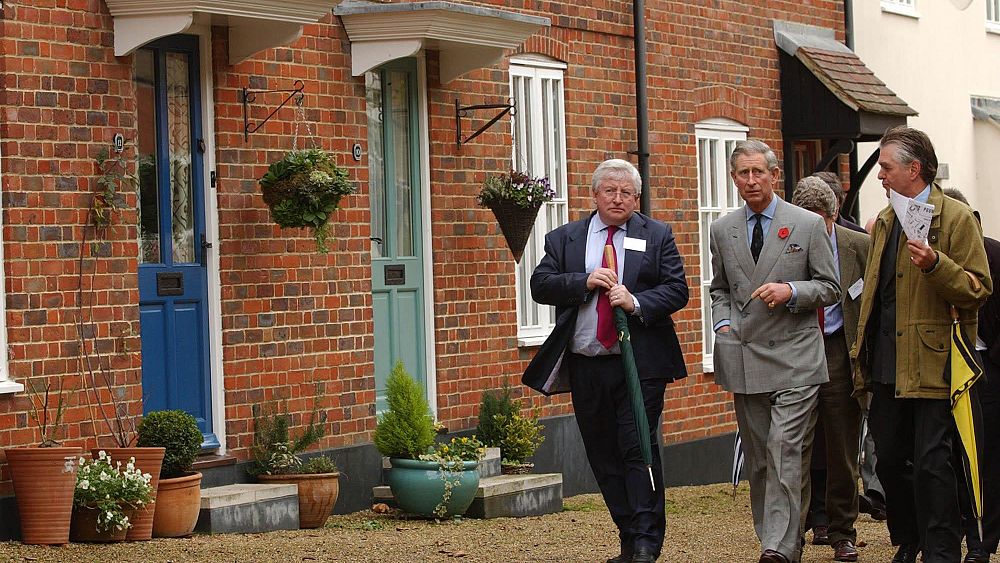The Village in Dorset, England combines progressive city planning with quintessential nostalgia in the ‘Make Britain Great Again!’ campaign. in the spirit of the slogan.
Poundbury is located in the south of England, only a three-hour drive from London, but aesthetically it is several centuries away from the British capital. The village on the outskirts of Dorchester is part of a whimsical project that will culminate on Saturday with a third. Caroli supports Make Britain Great Again! in the spirit of the slogan.
poundberry – According to an article in Politico – Combines progressive urban planning with idyllic nostalgia. The streets are lined with quaint, elegant brick houses, as if we were watching a Jane Austen movie: Victorian terraced houses, shadowy Gothic cottages, Regency townhouses, Palladian mansions, and a square with a mini Buckingham. The palace is in the center.
At first glance, this place looks great, but somehow it feels unsettlingly fake. The reason for this is that this windy and rainy corner of Dorset was just a muddy farmland before 1993, but over the past 30 years, Prince Charles has gradually transformed it into a model village to truly represent what he believes a British settlement should look like. Likes.
Angry Prince
In the 1980s, Prince Karolyi decided to divorce his second mother. With Queen Elizabeth’s famous appreciation, she “created” her public persona by commenting on social issues, hoping to make the detached monarchy more accessible to the public.
One of the subjects he began to take up was modern architecture, which Charles believed had “corrupted the character” of British cities by filling them with a built environment that did not reflect “civic virtues such as civility, prudence, and good manners”.
During his public appearances, the duke has often disparaged “monstrous” buildings such as London’s National Theater – which he called a “nuclear power plant” – and criticized Birmingham’s concrete city center and said the British Library building was “a kind of symbolic building”. “.
Educated architects noted that Caroli had no education in architectural and urban planning, but this did not impress Prince, who published his 1989 Vision for Britain, in which he expounded on the “generalized avant-garde” and argued for small, beautiful, pedestrian-friendly communities. In the same year he began the conversion of Poundbury, and has since built a model village on land belonging to the Duchy of Cornwall.
Karolyi strictly controlled the design and made sure it was in line with his vision of community living.
Rules, rules, rules
Simon Standish and his wife also moved from London to the environment created in this way. The retired consultant, who is a member of local residents’ association Love Poundbury, says he has no regrets about the move, but admits there are some strange aspects to life in Poundbury.
Standish also said that although Poundbury’s narrow, winding streets were designed to deter motorists from speeding, the lack of road signs in the village made further action difficult. A similar problem is that the Duchy is too reluctant to support the installation of solar panels in the village.
raises Standish, who also dislikes the fact that there are no community spaces in the village of more than 4,000 people that would facilitate communication and integration.
buildings in front of people
Most parks and squares have parking, so “people can’t mix with each other, and since most homes don’t have a front yard, they don’t really interact on the streets.”
Love Poundbury is trying to bring about change with an experiment called “Big Conversation”. Local residents are asked to share their views on how to make Poundberry more livable. Many have already taken the opportunity to complain about the duchy’s “semi-feudal” position, according to a resident who asked not to be identified.
Standish also says he has read Prince Charles’ book from 1989, but finds the main problem is the fact that the prince’s ideas are often “far-fetched and vague”.
Royal advertisement
Charles wouldn’t be the first British monarch to use architecture to make a statement. William the Conqueror and Edward I built castles such as Windsor and Caernarfon to consolidate their rule over England and later Wales, or VIII for example. Henrik also showed the greatness of the Tudor dynasty with a peerless palace now vanished.
In the last century, Karolyi’s immediate ancestors had abandoned the tradition of “royal building” and focused instead on sport. For example, Elizabeth was more interested in horse racing, says William White, professor of social and architectural history at St John’s College, Oxford.
The professor believes that the surprising thing about Karoli is that he does not use the building to advertise his personal power or wealth, but rather to “justify the ideological renaissance” that is trying to “overthrow” modernity and return to “a mixture of popular architecture and modernity.” classic”. White compares Poundberry to fanciful projects such as Marie Antoinette’s typical country village, Hameau de la Reine, where the Queen could escape the Versailles Protocol.
The professor also draws attention to the fact that there is “something distinctly Brexiteer” in the typical Caroli village, as he attempts to “denounce the experts and elite of the architectural profession”, while promoting an aesthetic imbued with nostalgia for Great Britain’s past.
Poundbury resident Simon Standish earlier says that because he is of European Jewish descent, Brexit is England’s retreat into “an older, no-nonsense romantic period”. Moving from London to Poundbury, the retired man feels like he’s “backed off a bit”. Although he lives in a nice community with people from interesting backgrounds, he fears that Poundbury will die soon, as the percentage of the population over the age of 65 is very high.












































